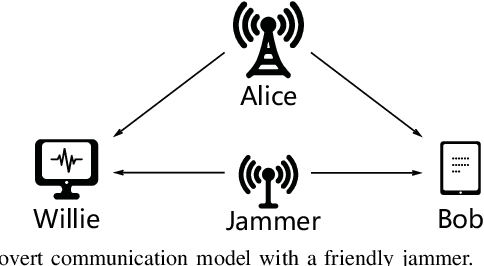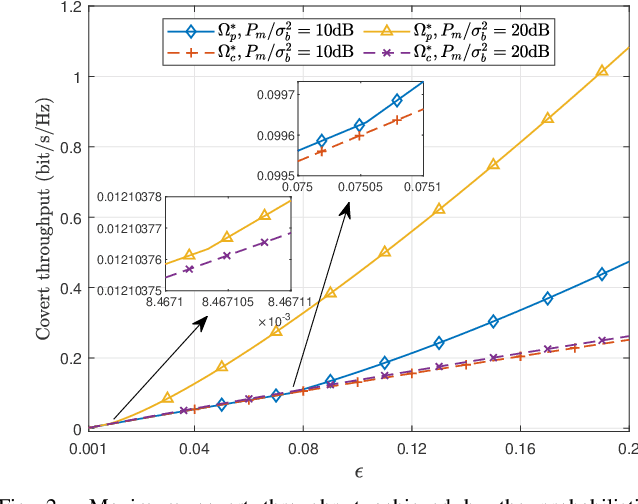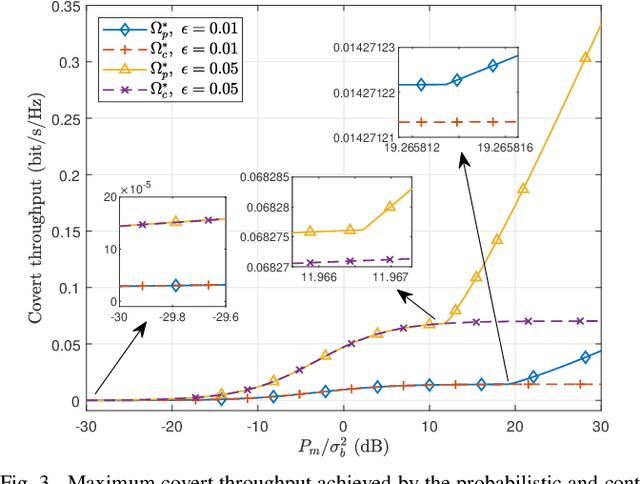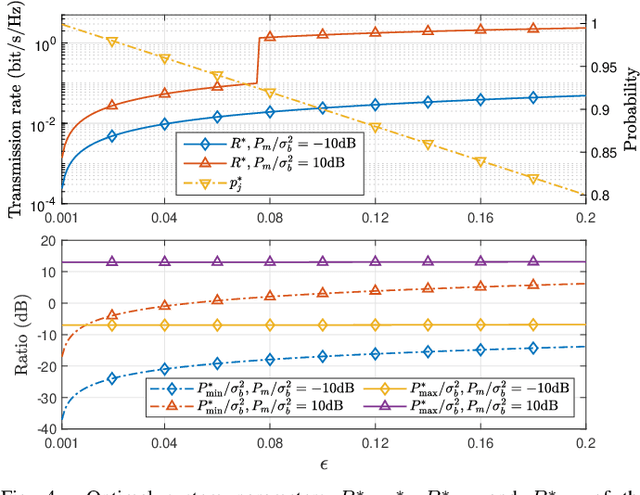Shihao Yan
Sensing-Then-Beamforming: Robust Transmission Design for RIS-Empowered Integrated Sensing and Covert Communication
Apr 18, 2025



Abstract:Traditional covert communication often relies on the knowledge of the warden's channel state information, which is inherently challenging to obtain due to the non-cooperative nature and potential mobility of the warden. The integration of sensing and communication technology provides a promising solution by enabling the legitimate transmitter to sense and track the warden, thereby enhancing transmission covertness. In this paper, we develop a framework for sensing-then-beamforming in reconfigurable intelligent surface (RIS)-empowered integrated sensing and covert communication (ISCC) systems, where the transmitter (Alice) estimates and tracks the mobile aerial warden's channel using sensing echo signals while simultaneously sending covert information to multiple legitimate users (Bobs) with the assistance of RIS, under the surveillance of the warden (Willie). Considering channel estimation errors, we formulate a robust non-convex optimization problem that jointly designs the communication beamformers, the sensing signal covariance matrix at Alice, and the phase shifts at the RIS to maximize the covert sum rate of Bobs while satisfying the constraints related to covert communication, sensing, transmitter power, and the unit modulus of the RIS elements. To solve this complex problem, we develop an efficient algorithm using alternating optimization, successive convex approximation, S-procedure, sequential rank-one constraint relaxation, and semidefinite relaxation techniques. Numerical results confirm the convergence of the proposed algorithm and demonstrate its effectiveness in tracking the warden's channel while ensuring robust covert transmission. Furthermore, the results highlight the advantages of using RIS to enhance the covert transmission rate compared to baseline schemes, and also illustrate the intricate trade-off between communication and sensing in ISCC systems.
Achieving Covert Communication With A Probabilistic Jamming Strategy
Aug 29, 2023



Abstract:In this work, we consider a covert communication scenario, where a transmitter Alice communicates to a receiver Bob with the aid of a probabilistic and uninformed jammer against an adversary warden's detection. The transmission status and power of the jammer are random and follow some priori probabilities. We first analyze the warden's detection performance as a function of the jammer's transmission probability, transmit power distribution, and Alice's transmit power. We then maximize the covert throughput from Alice to Bob subject to a covertness constraint, by designing the covert communication strategies from three different perspectives: Alice's perspective, the jammer's perspective, and the global perspective. Our analysis reveals that the minimum jamming power should not always be zero in the probabilistic jamming strategy, which is different from that in the continuous jamming strategy presented in the literature. In addition, we prove that the minimum jamming power should be the same as Alice's covert transmit power, depending on the covertness and average jamming power constraints. Furthermore, our results show that the probabilistic jamming can outperform the continuous jamming in terms of achieving a higher covert throughput under the same covertness and average jamming power constraints.
Beamforming Design for IRS-and-UAV-aided Two-way Amplify-and-Forward Relay Networks
Jun 01, 2023Abstract:As a promising solution to improve communication quality, unmanned aerial vehicle (UAV) has been widely integrated into wireless networks. In this paper, for the sake of enhancing the message exchange rate between User1 (U1) and User2 (U2), an intelligent reflective surface (IRS)-and-UAV- assisted two-way amplify-and-forward (AF) relay wireless system is proposed, where U1 and U2 can communicate each other via a UAV-mounted IRS and an AF relay. Besides, an optimization problem of maximizing minimum rate is casted, where the variables, namely AF relay beamforming matrix and IRS phase shifts of two time slots, need to be optimized. To achieve a maximum rate, a low-complexity alternately iterative (AI) scheme based on zero forcing and successive convex approximation (LC-ZF-SCA) algorithm is put forward, where the expression of AF relay beamforming matrix can be derived in semi-closed form by ZF method, and IRS phase shift vectors of two time slots can be respectively optimized by utilizing SCA algorithm. To obtain a significant rate enhancement, a high-performance AI method based on one step, semidefinite programming and penalty SCA (ONS-SDP-PSCA) is proposed, where the beamforming matrix at AF relay can be firstly solved by singular value decomposition and ONS method, IRS phase shift matrices of two time slots are optimized by SDP and PSCA algorithms. Simulation results present that the rate performance of the proposed LC-ZF-SCA and ONS-SDP-PSCA methods surpass those of random phase and only AF relay. In particular, when total transmit power is equal to 30dBm, the proposed two methods can harvest more than 68.5% rate gain compared to random phase and only AF relay. Meanwhile, the rate performance of ONS-SDP-PSCA method at cost of extremely high complexity is superior to that of LC-ZF-SCA method.
STAR-RIS-UAV Aided Coordinated Multipoint Cellular System for Multi-user Networks
May 22, 2023Abstract:Different with conventional reconfigurable intelligent surface (RIS), simultaneous transmitting and reflecting RIS (STAR-RIS) can reflect and transmit the signals to the receiver. In this paper, to serve more ground users and increase the deployment flexibility, we investigate an unmanned aerial vehicle equipped with a STAR-RIS (STAR-RIS-UAV) aided wireless communications for multi-user networks. Energy splitting (ES) and mode switching (MS) protocols are considered to control the reflection and transmission coefficients of STAR-RIS elements. To maximize the sum rate of the STAR-RIS-UAV aided coordinated multipoint cellular system for multi-user networks, the corresponding beamforming vectors as well as transmitted and reflected coefficients matrices are optimized. Specifically, instead of adopting the alternating optimization, we design an iteration method to optimize all variables for both ES and MS protocols at the same time. Simulation results reveal that STAR-RIS-UAV aided wireless communication system has a much higher sum rate than the system with conventional RIS or without RIS. Furthermore, the proposed structure is more flexible than a fixed STAR-RIS and could greatly promote the sum rate.
 Add to Chrome
Add to Chrome Add to Firefox
Add to Firefox Add to Edge
Add to Edge